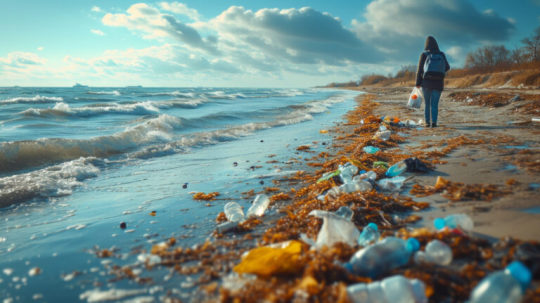#Biodegradation
Explore tagged Tumblr posts
Text
Remediation of Water Pollution by Plastics: A Strategic Approach 🌍💧
The world faces an unprecedented plastic pollution crisis, with plastic production reaching a staggering 330 billion tons annually. While plastic offers convenience, its environmental impact has become undeniable. Our water bodies, covering nearly two-thirds of the Earth, are heavily polluted by plastics, posing grave risks to aquatic ecosystems and human health. This blog explores key strategies to tackle plastic pollution and protect our water resources.
The Global Plastic Pollution Crisis 🛑🌊
Plastics, once seen as a breakthrough innovation, have now become a significant environmental challenge. From packaging to electronics, plastics are used in almost every sector. However, only less than 10% of plastics are recycled, and the rest end up in landfills or, worse, in our oceans and rivers. This ongoing issue has escalated, especially in aquatic environments, where plastics are causing lasting damage to marine life and freshwater ecosystems.
Water: Our Vital Resource Under Threat 💧❗
Water is essential for all life on Earth, making up 60% of the human body and crucial for survival. Yet, water pollution from plastic waste is an alarming issue. Oceans, which cover 98% of Earth’s water, are becoming increasingly contaminated with plastic debris. This pollution not only damages marine ecosystems but also affects freshwater sources, which are already under pressure from population growth and industrial activities.
A Three-Pronged Approach to Tackling Plastic Pollution 🌱🔬📊
To combat this growing crisis, experts propose a three-pronged approach:
Development of Bioplastics 🌿 Bioplastics, derived from renewable resources like plants and algae, present a sustainable alternative to conventional plastics. These biodegradable materials break down more easily in the environment, reducing plastic waste in water bodies. Investment in bioplastics can help phase out traditional plastics and limit further contamination.
Biodegradation Using Microorganisms 🦠 Microorganisms capable of breaking down plastics offer another solution. Certain bacteria and fungi can decompose plastics like polyethylene and polystyrene. Harnessing these natural processes could accelerate plastic breakdown in water bodies and help mitigate the damage.
Raising Awareness and Policy Reform 🗣️📜 Public awareness about the dangers of plastic pollution is crucial. Communities must be educated on sustainable waste management practices, while governments must implement policies that regulate plastic production, promote recycling, and encourage the use of eco-friendly alternatives.
The Role of Policy and Global Cooperation 🌎🤝
Plastic pollution is a global issue that requires cooperation across borders. Governments, international organizations, and research institutions must collaborate to create policies that regulate plastic production, improve waste management systems, and support sustainable practices. Strong policy reforms can help reduce plastic use, encourage bioplastics, and raise awareness.
Conclusion: A Call for Action 🚨🌱
The pollution of our water bodies by plastics is a growing environmental threat. Immediate action is required to develop bioplastics, utilize biodegradation techniques, and implement strong policies to protect our water resources. By adopting these strategies, we can restore the health of our aquatic ecosystems and ensure a cleaner, safer planet for future generations.
Read Full Article: Remediation of Water Pollution by Plastics: A Strategic Approach
https://go.nature.com/4jp7f0I
https://doi.org/10.1007/978-3-030-52395-4_3

#academia#books#literature#nature#university#PlasticPollution#WaterPollution#Bioplastics#SustainableSolutions#EcoFriendly#PlasticWaste#MarineConservation#ClimateAction#GreenInnovation#WaterConservation#Biodegradation#EnvironmentalImpact#SaveOurOceans#EcoAwareness#PollutionSolution#EnvironmentalPolicy#SustainableFuture#ProtectOurPlanet#PlasticFree#GlobalCooperation#ReducePlastic#CleanWater#EcoRevolution#GreenTechnology
2 notes
·
View notes
Text
maquina bolseadora confeccionadora para bolsas fondo polietileno Guadalajara puebla leon Cuidad de Mexico
maquina bolseadora confeccionadora para bolsas fondo polietileno Guadalajara puebla leon Cuidad de Mexico
#maquina#bolseadora#confeccionadora#bolsas#polietileno#selladora#plastico#plasticas#biodegradable#biodegradation#biodegradalematerials
2 notes
·
View notes
Text
Trump: STOP BEING MEAN TO MY FRIEND'S BUSINESS! BOYCOTTING IS ILLEGAL! I WILL MAKE YOU BUY HIS STUFF!
Me, gazing into Boston Harbor with a tear in my eye: that's what they said about the British East India Company my dude
46K notes
·
View notes
Text
Global Bioremediation Market Analysis: Trends, Innovations, and 2025 Forecast Study
#Bioremediation#Environmental Remediation#Pollution Control#Sustainable Cleaning#Eco-Friendly#Microbial Remediation#Waste Management#Green Technology#Soil Remediation#Water Treatment#Bioaugmentation#Biostimulation#Environmental Protection#Clean Energy#Eco Solutions#Contaminant Removal#Biodegradation#Oil Spill Cleanup#Heavy Metal Removal#Sustainable Future
0 notes
Link
1 note
·
View note
Text
Una descripción general de las enzimas que degradan el poliuretano

Los poliuretanos (PUR) son polímeros sintéticos ampliamente utilizados en diversas aplicaciones industriales. Sin embargo, su durabilidad plantea un desafío significativo en términos de degradabilidad y reciclabilidad. Con el aumento de la producción de plásticos, que superó los 21 millones de toneladas en 2022, la gestión de residuos de PUR se ha vuelto crítica.
Polyurethanes (PUR) are synthetic polymers widely used in various industrial applications. However, their durability presents a significant challenge in terms of degradability and recyclability. With plastic production surpassing 21 million tons in 2022, PUR waste management has become a critical issue.
#PUR#Enzimas#Enzymes#Reciclaje#Recycling#Biodegradación#Biodegradation#Sostenibilidad#Sustainability
0 notes
Text
🌿 Biodegradable Sponges: Hype or True Sustainability? 🧽♻️
Your kitchen sponge might be doing more harm than you think—shedding microplastics into our water every time you clean. 😬 But are biodegradable sponges really the solution, or just another case of greenwashing?
✨ What to look for: ✔️ Natural materials like cellulose, loofah, or coconut fiber ♻️ Proper disposal—biodegradable doesn’t mean landfill-friendly! 🚨 Beware of greenwashing—not all “eco” labels are legit!
If you’re serious about sustainable swaps, here’s what you need to know 👉 GreenFutureDaily.com
#SustainableLiving #ZeroWaste #EcoFriendly #GreenChoices
1 note
·
View note
Text

TSRNOSS, p 588.
#high altitude populations#bacterial conjugation#oligotrophic lakes#detergents#deoxycholic acid#deoxyribose#disinfectants#potassium permanganate#oxidation of ferrous iron#electroconvulsive shock#ozone#xenobiotics#aromatic ring#biodegradation#trophic level#mercury#volcanoes#brain#metabolic rate#gas equation#gas bladder#carbon monoxide#spores#oligotrophs#ultraviolet light#high altitude#mutation
0 notes
Text
Say Hello to Biodegradable Microplastics - Technology Org
New Post has been published on https://thedigitalinsider.com/say-hello-to-biodegradable-microplastics-technology-org/
Say Hello to Biodegradable Microplastics - Technology Org
Microplastics are tiny, nearly indestructible fragments shed from everyday plastic products. As we learn more about microplastics, the news keeps getting worse. Already well-documented in our oceans and soil, we’re discovering them in the unlikeliest places: our arteries, lungs and even placentas.
Particle counts of petroleum-based (EVA) and plant-based (TPU-FC1) microplastics show that, over time, EVAs exhibit virtually no biodegradation, while the TPUs have mostly disappeared by day 200.
Microplastics can take anywhere from 100 to 1,000 years to break down and, in the meantime, our planet and bodies are becoming more polluted with these materials every day.
Finding viable alternatives to traditional petroleum-based plastics and microplastics has never been more important. New research from scientists at the University of California San Diego and materials science company Algenesis shows that their plant-based polymers biodegrade — even at the microplastic level — in under seven months. The paper, whose authors are all UC San Diego professors, alumni or former research scientists, appears in Nature Scientific Reports.
“We’re just starting to understand the implications of microplastics. We’ve only scratched the surface of knowing the environmental and health impacts,” stated Professor of Chemistry and Biochemistry Michael Burkart, one of the paper’s authors and an Algenesis co-founder. “We’re trying to find replacements for materials that already exist, and make sure these replacements will biodegrade at the end of their useful life instead of collecting in the environment. That’s not easy.”
“When we first created these algae-based polymers about six years ago, our intention was always that it be completely biodegradable,” said another of the paper’s authors, Robert Pomeroy, who is also a professor of chemistry and biochemistry and an Algenesis co-founder. “We had plenty of data to suggest that our material was disappearing in the compost, but this is the first time we’ve measured it at the microparticle level.”
Putting it to the test
To test its biodegradability, the team ground their product into fine microparticles, and used three different measurement tools to confirm that, when placed in a compost, the material was being digested by microbes.
The first tool was a respirometer. When the microbes break down compost material, they release carbon dioxide (CO2), which the respirometer measures. These results were compared to the breakdown of cellulose, which is considered the industry standard of 100% biodegradability. The plant-based polymer matched the cellulose at almost one hundred percent.
Next the team used water flotation. Since plastics are not water soluble and they float, they can easily be scooped off the surface of water. At intervals of 90 and 200 days, almost 100% of the petroleum-based microplastics were recovered, meaning none of it had biodegraded. On the other hand, after 90 days, only 32% of the algae-based microplastics were recovered, showing that more than two thirds of it had biodegraded. After 200 days, only 3% was recovered indicating that 97% of it had disappeared.
The last measurement involved chemical analysis via gas chromatography/mass spectrometry (GCMS), which detected the presence of the monomers used to make the plastic, indicating that the polymer was being broken to its starting plant materials. Scanning-electron microscopy further showed how microorganisms colonize the biodegradable microplastics during composting.
“This material is the first plastic demonstrated to not create microplastics as we use it,” said Stephen Mayfield, a paper coauthor, School of Biological Sciences professor and co-founder of Algenesis. “This is more than just a sustainable solution for the end-of-product life cycle and our crowded landfills. This is actually plastic that is not going to make us sick.”
Creating an eco-friendly alternative to petroleum-based plastics is only one part of the long road to viability. The ongoing challenge is to be able to use the new material on pre-existing manufacturing equipment that was originally built for traditional plastic, and here Algenesis is making progress. They have partnered with several companies to make products that use the plant-based polymers developed at UC San Diego, including Trelleborg for use in coated fabrics and RhinoShield for use in the production of cell phone cases.
“When we started this work, we were told it was impossible,” stated Burkart. “Now we see a different reality. There’s a lot of work to be done, but we want to give people hope. It is possible.”
Source: UCSD
You can offer your link to a page which is relevant to the topic of this post.
#000#algae#Analysis#arteries#biochemistry#biodegradable#biodegradable materials#biodegradation#carbon#Carbon dioxide#cell#cell phone#cellulose#challenge#chemical#chemical analysis#chemistry#Chemistry & materials science news#CO2#Companies#data#easy#electron#Environment#Environmental#equipment#gas#hand#Health#how
0 notes
Text
0 notes
Text
0 notes
Text
Global Bioremediation Market Analysis Business Revenue Forecast Size Leading Competitors And Growth Trends
The Global Bioremediation Market is witnessing remarkable momentum as industries increasingly seek sustainable methods to combat environmental pollution. With ecosystems under pressure from industrial waste, oil spills, and hazardous contaminants, bioremediation has emerged as a nature-driven solution that utilizes microorganisms and plants to clean up air, water, and soil. As of 2023, the market stood at USD 14.4 billion and is forecasted to reach USD 36.3 billion by 2032, growing at a CAGR of 10.8%.
Discover full insights into the bioremediation market in our latest comprehensive research.
Understanding Bioremediation: Nature’s Cleanup Crew
Bioremediation refers to the use of biological organisms—such as bacteria, fungi, and plants—to degrade or neutralize pollutants from the environment. Compared to conventional approaches like incineration or chemical treatments, bioremediation is environmentally safe, cost-efficient, and less disruptive.
The need for such solutions is becoming critical in industries such as mining, petroleum, agriculture, and wastewater management, where contamination levels are rising globally.
Key Factors Fueling Market Expansion
✔ Environmental Compliance on the Rise
Governments across the world are tightening regulations to curb pollution. These policies are encouraging industries to adopt green technologies like bioremediation, which align well with low-emission goals.
✔ Pollution from Heavy Industry
Sectors such as oil & gas, chemicals, and metallurgy generate large volumes of pollutants. Bioremediation offers a scalable and effective method to mitigate these environmental threats.
✔ Advances in Biotechnology
Recent innovations in enzyme technology, microbial genetics, and synthetic biology have greatly improved the performance and range of bioremediation applications.
✔ Eco-Conscious Stakeholders
With increased global awareness around climate change, stakeholders—including consumers, investors, and regulators—are demanding sustainable solutions, accelerating market demand.
🔍 For a full sample analysis, get your free PDF here: https://dimensionmarketresearch.com/report/bioremediation-market/request-sample/
Core Technologies Driving the Market
Bioremediation techniques are evolving to handle a variety of pollutants under different environmental conditions.
In Situ Bioremediation
Treats contamination directly at the site, avoiding excavation costs:
Bioventing: Supplies oxygen to stimulate aerobic microbes.
Biosparging: Introduces air and nutrients into groundwater.
Ex Situ Bioremediation
Removes contaminants for off-site treatment:
Slurry-phase Bioreactors
Biopiles
Landfarming
Phytoremediation
Harnesses plants to absorb or break down pollutants—ideal for heavy metal removal and soil restoration.
Bioaugmentation
Introduces specialized microbial strains to contaminated sites, especially where native populations are insufficient.
Application Sectors
Bioremediation technologies serve various industries with tailored applications:
Oil & Gas: Hydrocarbon degradation and spill cleanup
Mining: Soil and water decontamination
Agriculture: Detoxification of pesticides and fertilizers
Wastewater Treatment: Removal of organic waste
Pharmaceuticals: Cleanup of manufacturing byproducts
Regional Market Trends
🌎 North America
Holding over 42% of the global market share in 2023, North America dominates due to:
Strong environmental enforcement from the U.S. EPA
Technological leadership in microbial and bioprocess research
High demand from industrial sectors
🌍 Europe
With ambitious climate goals, countries like Germany, France, and the Netherlands are prioritizing eco-friendly remediation solutions through EU-supported initiatives.
🌏 Asia-Pacific
This region is expected to post the fastest growth, driven by rapid industrial expansion, urban pollution, and increasing environmental awareness across China, India, and Southeast Asia.
Market Challenges vs. Emerging Opportunities
⚠ Challenges
Slow Remediation Pace: Some bioremediation processes take longer compared to chemical treatments.
Site-Specific Performance: Factors like soil composition, pH, and temperature affect results.
Lack of Uniform Standards: Especially in developing regions, regulatory gaps persist.
✅ Opportunities
AI & IoT Integration: Advanced sensors can monitor microbial activity in real time.
Tailor-Made Microbes: Custom-designed strains offer more efficient cleanup solutions.
Collaborative Initiatives: Governments and private companies are joining forces to scale bioremediation across regions.
�� Access the full market report here: https://dimensionmarketresearch.com/report/bioremediation-market/
Key FAQs
1. What’s fueling the growth of the bioremediation market? Growth is driven by stricter environmental laws, rising industrial pollution, biotechnological breakthroughs, and a shift toward sustainability.
2. What are the core technologies used? In situ and ex situ bioremediation, phytoremediation, and bioaugmentation are the primary methods used.
3. Which region leads the market? North America, led by the U.S., currently holds the largest market share.
4. What industries benefit most? Key beneficiaries include oil & gas, mining, agriculture, wastewater treatment, and pharmaceuticals.
5. How large is the market projected to be by 2032? The global market is expected to reach USD 36.3 billion by 2032, at a CAGR of 10.8%.
Final Outlook
The Global Bioremediation Market is becoming a cornerstone of environmental restoration. By blending natural systems with technological innovation, it offers a sustainable path forward for industries and governments alike. As awareness, investment, and innovation continue to rise, bioremediation is set to play a defining role in building a cleaner, greener future.
📄 Don’t miss out—download your free sample report today: https://dimensionmarketresearch.com/report/bioremediation-market/request-sample/
#Bioremediation#EnvironmentalRemediation#PollutionControl#SustainableCleaning#EcoFriendly#MicrobialRemediation#WasteManagement#GreenTechnology#SoilRemediation#WaterTreatment#Bioaugmentation#Biostimulation#EnvironmentalProtection#CleanEnergy#EcoSolutions#ContaminantRemoval#Biodegradation#OilSpillCleanup#HeavyMetalRemoval#SustainableFuture
0 notes
Link
1 note
·
View note
Text
From the article:
Researchers led by Takuzo Aida at the RIKEN Center for Emergent Matter Science (CEMS) have developed a durable plastic that won’t contribute to microplastic pollution in our oceans. The new material is as strong as conventional plastics and biodegradable, but what makes it special is that it breaks down in seawater. The new plastic is therefore expected to help reduce harmful microplastic pollution that accumulates in oceans and soil and eventually enters the food chain.
#biodegradable plastic#plastic#microplastic#microplastic pollution#plastic pollution#ocean pollution#ocean conservation#good news#hope#hopepunk#habitat#environment#ecology
974 notes
·
View notes
Text





Mossy mushroomy A-frame cabin commission, with its little pals
I got no photos of my favorite design decision: ceramic "rafters" supporting the needlefelted moss. They'll get their time to shine whenever the felt biodegrades, which will be a while.
#little clay fellows#for this one i got sent an entire pinterest board. and it was delightful#apparently wool takes 3 months to 2 years to biodegrade when buried. not so likely for this guy i will say
2K notes
·
View notes
Text
Plastic-Eating Worms: A Revolutionary Discovery
In a world where plastic pollution is one of the most pressing environmental issues, a groundbreaking discovery has emerged: worms that can consume and break down plastic. This remarkable finding could potentially revolutionize the way we manage plastic waste, offering a biodegradable solution to this global challenge.
The discovery of these plastic-eating worms highlights the incredible adaptability of nature and opens up new avenues for research and development in waste management. Scientists are now exploring the potential of these worms to help reduce the accumulation of plastic in landfills and oceans.
The implications of this discovery are vast. Not only could it help mitigate the environmental impact of plastic waste, but it also presents an opportunity to develop sustainable practices for recycling and waste reduction. The research is still in its early stages, but the future looks promising.
As we continue to explore the capabilities of these worms, we must also consider the ethical and ecological aspects of utilizing living organisms for waste management. It is crucial to ensure that these methods are safe, effective, and do not disrupt the delicate balance of ecosystems.
The journey towards a plastic-free environment is long, but with innovations like plastic-eating worms, we are taking significant steps forward. It is a reminder that sometimes, the solutions we seek can be found in the most unexpected places.
This discovery is not just a scientific breakthrough; it's a beacon of hope for a cleaner, greener future. Let's embrace these natural problem-solvers and support the research that could lead us to a more sustainable world.
via 👉 @mezzopieno-news
.
.
SCOPERTI VERMI CHE MANGIANO E SMALTISCONO LA PLASTICA

I ricercatori del laboratorio guidato dalla biologa molecolare Federica Bertocchini hanno fatto una scoperta sorprendente: i vermi della cera, considerati fino a ieri soltanto dei parassiti, stanno rivelando un talento inaspettato per digerire la plastica. Gli scienziati hanno osservato come questi vermi, entrando in contatto con sacchetti di plastica, iniziassero a fare buchi e a digerire il materiale di cui erano fatti. La saliva di questi lombrichi contiene infatti potenti enzimi, Ceres e Demeter, capaci di rompere il polietilene della plastica. Nonostante la scoperta sia promettente, l’implementazione su larga scala di questi enzimi è ancora in una fase iniziale. Tuttavia Bertocchini, ora presso la Plasticentropy France, si dice ottimista sul suo potenziale e vede questi enzimi come una possibile soluzione globale per l’inquinamento da plastica. Oltre ai vermi della cera, anche funghi e batteri mostrano caratteristiche simili nello smaltimento della plastica, ricordandoci il potenziale della natura per aiutarci a affrontare le sfide ambientali. Nel frattempo, sono in corso i negoziati tra gli Stati membri delle Nazioni Unite per giungere alla stipula del trattato globale sull’inquinamento da plastica, un accordo giuridicamente vincolante per contrastare l’inquinamento da plastica a livello globale atteso per il 2025.
___________________
Fonte: Federica Bertocchini

VERIFICATO ALLA FONTE | Guarda il protocollo di Fact checking delle notizie di Mezzopieno
BUONE NOTIZIE CAMBIANO IL MONDO | Firma la petizione per avere più informazione positiva in giornali e telegiornali

Se trovi utile il nostro lavoro e credi nel principio del giornalismo costruttivo non-profit | sostieni Mezzopieno
#plastic pollutions#waste management#sustainable solutions#biodegradation#eco friendly#nature solutions#mezzopieno news
24 notes
·
View notes